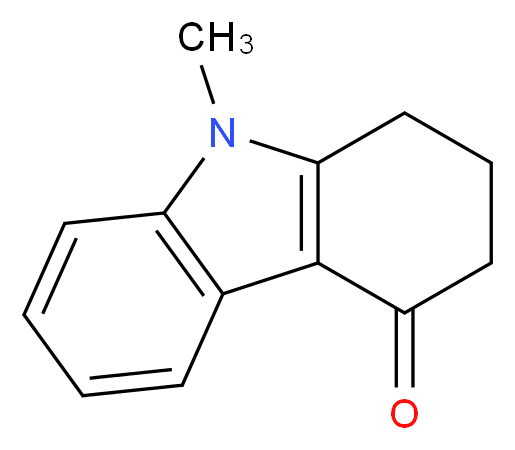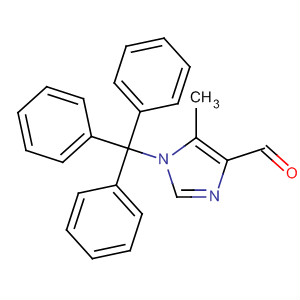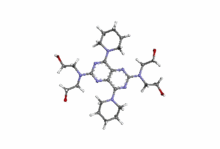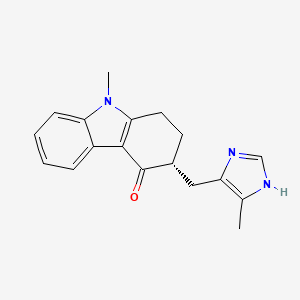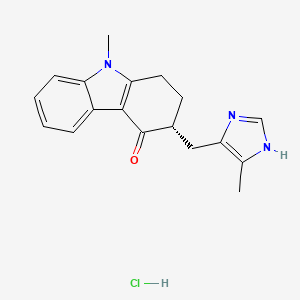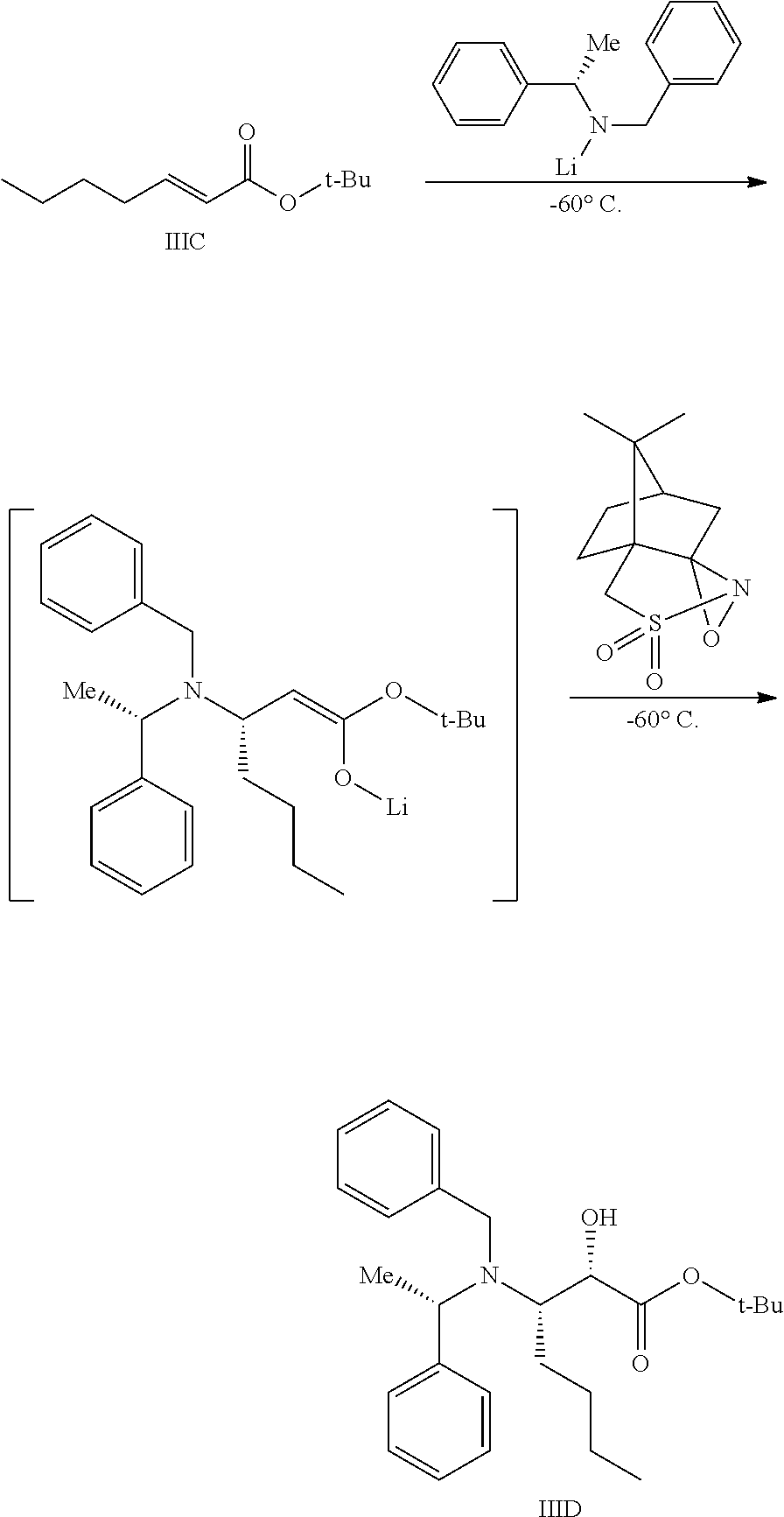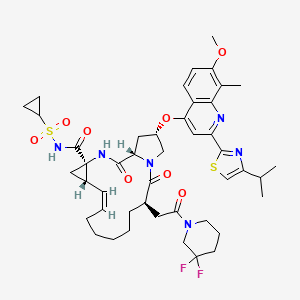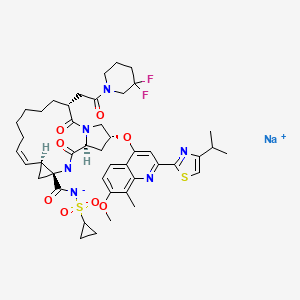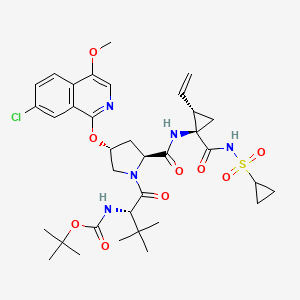
FILIBUVIR
PFIZER
PF-868554 is an anti-hepatitis C drug candidate which had been in phase II clinical trials at Pfizer; however this research has been discontinued.
Li, H.; Tatlock, J.; Linton, A.; et al
Discovery of (R)-6-cyclopentyl-6-(2-(2,6-diethylpyridin-4-yl)ethyl)-3-((5,7-dimethyl-(1,2,4)triazolo(1,5-a)pyrimidin-2-yl)methyl)-4-hydroxy-5,6-dihydropyran-2-one (PF-00868554) as a potent and orally available hepatitis C virus polymerase inhibitor
J Med Chem 2009, 52(5): 1255
Johnson, S.; Drowns, M.; Tatlock, J.; et al.
Synthetic route optimization of PF-00868554, an HCV polymerase inhibitor in clinical evaluation
Synlett (Stuttgart) 2010, 2010(5): 796
WO 2012016995
WO 2013101550
WO 2011072370
WO 2007023381
WO 2006018725
| WO2003095441A1 * |
7 mei 2003 |
20 nov 2003 |
Melwyn A Abreo |
Inhibitors of hepatitis c virus rna-dependent rna polymerase, and compositions and treatments using the same |
| WO2006018725A1 * |
5 aug 2005 |
23 feb 2006 |
Pfizer |
Inhibitors of hepatitis c virus rna-dependent rna polymerase, and compositions and treatments using the same |
| US20050176701 * |
19 nov 2003 |
11 aug 2005 |
Agouron Pharmaceuticals, Inc. |
Inhibitors of hepatitis C virus RNA-dependent RNA polymerase, and compositions and treatments using the same…
|
WO2007023381A1
Example 1 : Preparation of the glycolate salt of (5-amino-1H-1,2,4-triazol-3-yl)methanol
glycolate salt
Glycolic acid (1 L, 70% in water, 11.51 mol) was added to a 5 L flask. To the solution was slowly added aminoguanidine bicarbonate (783.33 g, 5.755 mol) in portions to control significant bubbling. As solids are added, the solution cools due to endothermic dissolution. The solution was gently heated to maintain an internal temp of 25 °C during addition. Ten minutes after complete addition of aminoguanidine bicarbonate, cone. Nitric acid (6.8 ml_) was carefully added. The solution was heated to an internal temperature of 104-108 0C (mild reflux) for 22 h. The heating was discontinued and the solution allowed to cool, with stirring. At an internal temp of aboutδi °C, solids began to crystallize. After the internal temperature was just below 80 0C, ethanol (absolute, 375 mL) was slowly added to the mixture. After the internal temp had cooled to aboutδδ 0C1the cooling was sped up by the use of an ice/water bath. After cooling below rt, the solution became very thick but remained stirrable at all times. The slurry was stirred for 2h at T<10 0C, then filtered and the solids rinsed with ethanol (900 mL cold, then 250 mL rt). The solids were dried overnight in a vacuum oven (about25 mmHg, 45-50 0C) to provide 815.80 g (75%) of (5-amino-1H-1 ,2,4-triazol-3-yl)methanol as the glycolate salt. 1H (300 MHz, de-DMSO): 3.90 (s, 2), 4.24 (s, 2).
Example 2: Preparation of (5,7-dimethyl[1,2,4]triazolo[1,5-a]pyrimidin-2-yl)methanol
To a 2L, 3-neck flask was charged glycolate salt of (5-amino-1tf-1 ,2,4-triazol-3-yl)methanol (99.93 g, 0.526 mol), 2,4 pentanedione (0.578 mols, 60 mL), acetic acid (6.70 mL), and EtOH (550 mL). The mixture was heated to a slight reflux. One hour after adding the reagents, the resulting solution was cooled to ambient temperature, and CH2CI2 (500 mL) and Celite (25.03 g) were added. After stirring for 1 h, the mixture was filtered through a 4″ Buchner funnel packed with celite (20 g) and rinsed with EtOH (100 mL). The solution was distilled to 5 vols then cooled to 0 °C for 1-2 hours. The slurry was filtered and the cake was rinsed with cold EtOH (2×100 mL). The solids were dried to provide 76.67 g (81.7%) of the title compound.
1H NMR (300 MHz, d6-DMSO): 2.57 (s, 3), 2.71 (d, 3, J=0.8), 4.63 (uneven d, 2, J=5.7), 5.49
(t, 1 , J=6.2), 7.13 (d, 1 , J=0.8).
Example 3: Preparation of 5,7-dimethyl[1 ,2,4]triazolo[1 ,5-a]pyrimidine-2-carbaldehyde

To a 10 L reactor was sequentially charged CH2CI2 (5.1 L)1 (5,7- dimethyl[1 ,2,4]triazolo[1 ,5-a]pyrimidin-2-yl)methanol (680 g, 3.816 mol), and iodobenzene diacetate (1352 g, 4.197 mol). As the iodobenzene diacetate dissolves, there is a significant endotherm (typically down to 15-16 0C). The jacket was set to 23 0C. The mixture was warmed to ambient temperature and Tempo (2,2,6,6-tetramethyl-1-piperidinyloxy, free radical, 43.75 g, 0.28 mol) added in a single charge. The reaction was stirred until 5% of the starting alcohol remained by HPLC. Once the starting material is adjudged to be less than about about5%, the over-oxidized product begins to be observed. Allowing the reaction to run to further completion leads to an overall diminished yield of the desired product. For this reaction, the desired reaction completion was reached in 2.75 h. MTBE (5.1 L) was then slowly charged to the reactor, causing the product to precipitate, and the slurry stirred for an additional 30 mins. The mixture was filtered, washed twice with 1 :1 DCM/MTBE (2 x 1 L), and dried in a vacuum oven overnight at 50 0C to provide 500.3 g (74%) of 5,7- dimethyl[1,2,4]triazolo[1 ,5-a]pyrimidine-2-carbaldehyde as an off-white solid. 1H NMR (300 MHz, ds-DMSO): 2.64 (s, 3), 2.78 (d, 3, J=0.8), 7.36 (d, 1 , J=0.9), 10.13 (s, 1). Example 4: Preparation of the dibenzoyl-L-tartaric acid salt of 1-cyclopentyl-3-(2,6- diethylpyridin-4-yl)propan-1-one

DMAC
L-DBTA NEt3-HOTs + LiBr + NEt3-HBr THF/MTBE

A nitrogen-purged, 5-L, 3-neck flask containing 4-bromo-2,6-diethylpyridine (250.0 g, 0.6472 mol) was sequentially charged with LiBr (112.42 g, 1.2944 mol), 1-cyclopentyl-prop-2- en-1-ol ( 89.84 g, 0.7119 mol), DMAc (625 mL), and H2O (55.0 mL). The mixture was cooled to 5-10 0C and was then purged (subsurface) with N2 for 30 minutes. The flask was charged with Et3N (198.5 mL, 1.4242 mol) and Pd(OaC)2 (3.63 g, 0.0162 mol), followed by a careful purge of the headspace. The reaction was heated until the internal temperature reached 95 0C. After stirring at 95 °C for three hours, an aliquot was removed and analyzed by HPLC, showing >99% conversion to 1-cyclopentyl-3-(2,6-diethylpyridin-4-yl)propan-1-one. The reaction was then cooled to 30 0C over 20 min. The flask was charged with H2O (1500 mL), and MTBE (1500 mL). The solution was stirred well for 5 minutes before the mixture was allowed to settle and the aqueous layer was removed. To the organic layer was charged Celite (62.5Og), and Darco G-60 (6.25g). The slurry was stirred for 20 minutes at 20-25 0C. The slurry was then filtered using a Buchner funnel dressed with Celite. The filter cake was rinsed with MTBE (250 mL). The organic layer was extracted with 5% sodium bicarbonate solution (500 mL) and the phases separated. The organic layer was transferred to a 5 L, three-neck flask, and MTBE added to achieve a total reaction volume of 1750 mL. Additional MTBE (1500 mL) was added and atmospherically distilled until an internal volume of 1750 mL was reached. After cooling below 40 0C, a sample was removed for analysis of water content. After cooling to 20-25 0C, MTBE (250 mL) was added to bring the total volume to 2000 mL and the solution was seeded with crystals of the dibenzoyl-L-tartaric acid salt of 1-cyclopentyl-3-(2,6- diethylpyridin-4-yl)propan-1-one (130 mg), which were prepared according to this procedure. A solution of dibenzoyl-L-tartaric acid (231.89 g, 0.6472 mol) in THF (900 mL) was added over 25 minutes. The slurry was granulated for 1 hour, the mixture was filtered, and the cake rinsed with MTBE (450 mL). The solids were dried in a vacuum oven at 50 0C for 12 h to provide 366.70 g (92% yield) of the title compound. 1H NMR (300 MHz, d6-DMSO): 1.19 (t, 6, J=7.6), 1.47-1.81 (m, 8), 2.73 (q, 4, J=7.6), 2.73-2.98 (m, 5), 5.86 (s, 2), 7.00 (S1 2), 7.55-7.63 (m, 4), 7.68-7.75 (m, 2), 7.98-8.04 (m, 4).
Example 5: Preparation of 3-cyclopentyl-5-(2,6-diethylpyridin-4-yl)-3-hydroxypentanoic acid
A 3-L, 3-neck flask was charged with the dibenzoyl-L-tartaric acid salt of 1- cyclopentyl-3-(2,6-diethylpyridin-4-yl)propan-1-one (174.95 g, 0.2832 mol), MTBE (875 mL), water (875 mL), and triethanolamine (113.0 mL, 0.8513 mol). After stirring for 2 h at rt, an aliquot of the aqueous phase was removed and analyzed by HPLC, showing no detectable starting material. The solution was transferred to a separatory funnel and the layers separated. The lower aqueous phase was discarded and the upper org. phase was washed with water (150 mL). The organic layer was added to a flask set up for distillation. The solution was distilled down to approx. 183 mL and an aliquot was removed and analyzed for water content. The dry solution of 1-cyclopentyl-3-(2,6-diethylpyridin-4-yl)propan-1-one (th. Wt = 73.47 g) in MTBE was used directly in the next step.
A clean 2-L, 3-neck flask was charged with LiHMDS (1.0 M in THF, 355 mL, 0.355 mol) and purged with nitrogen. The flask was cooled to -34 0C. An addition funnel was then charged with EtOAc (35 mL, 0.3583 mol) and this reagent was slowly added to the reaction vessel at such a rate that the low temperature of the vessel could be maintained. After complete EtOAc addition another addition funnel was charged with the 1-cyclopentyl-3-(2,6- diethylpyridin-4-yl)propan-1-one solution (crude MTBE soln from prior reaction, theor. 73.47 g, 0.2832 mol) and rinsed over with THF (anhydrous, 5 ml_). The 1-cyclopentyl-3-(2,6- diethylpyridin-4-yl)propan-1-one solution was slowly added to the reaction flask at such a rate that the low internal temperature could be maintained. Five minutes after complete addition, a reaction aliquot was removed and analyzed by HPLC, showing less than 1% 1-cyclopentyl-3- (2,6-diethylpyridin-4-yl)propan-1-one. Ten minutes after complete ketone addition, the bath was switched to O 0C. Once the internal temperature had warmed to -10 0C, 1 M NaOH (510 mL) was added. After complete NaOH soln addition, the reaction was heated to 50 0C. After 21 hours the reaction solution was cooled below 30 0C and an aliquot of both layers was removed and analyzed for completion. The mixture was added to a separatory funnel with MTBE (350 mL) and the phases were mixed well and separated. An aliquot of the organic phase was analyzed by HPLC, verifying no significant product, and this layer was discarded. The aqueous phase was added to a flask with CH2CI2(350 mL). Concentrated aqueous HCI (about 100 mL) was slowly added to the aqueous phase until the pH = 5. The mixture was added back to a separatory funnel and mixed well. The phases were separated and the aqueous layer was extracted a second time with CH2CI2 (150 mL). The organic layers were combined and charged to a clean flask set up for distillation. The solution was distilled down to 370 mL then displaced with THF by addition of solvent portions followed by continued distillation down to 370 mL after each addition. When the distillation head temp, held steady at 65 °C for 30 min an aliquot was removed and analyzed by 1H NMR, showing a 12.5:1 ratio of THF:CH2CI2. The solution of 3-cyclopentyl-5-(2,6-diethylpyridin-4-yl)-3-hydroxypentanoic acid in THF was used directly in the next step.
Example 6a: Preparation of the (1R,2R)-(-)-2-amino-1-(4-nitrophenyl)-1,3-propanedioI salt of ®-3-cyclopentyl-5-(2,6-diethylpyridin-4-yl)-3-hydroxypentanoic acid

A 2-L, 3-neck flask was sequentially charged with a solution of 3-cyclopentyl-5-(2,6- diethylpyridin-4-yl)-3-hydroxypentanoic acid (crude from last step, theoretical 95.28 g, 0.1792 mol, in about300 mL), (1 R,2R)-(-)-2-amino-1-(4-nitrophenyl)-1 ,3-propanediol (38.03 g, 0.1792 moles) and THF (415 mL). A seed crystal of the (1R,2R)-(-)-2-amino-1-(4-nitrophenyl)-1 ,3- propanediol salt of ®-3-cyclopentyl-5-(2,6-diethylpyridin-4-yl)-3-hydroxypentanoic acid, prepared according to this procedure, was added and the mixture was stirred and heated to 65 0C, then held at this temperature for 16 h. The slurry was cooled slowly to rt and stirred for at least 1 h. The slurry was filtered and the cake rinsed with THF (100 mL). The filtrate (solution of (S)-3-cyclopentyl-5-(2,6-diethylpyridin-4-yl)-3-hydroxypentanoic acid in THF) was used directly in the next procedure. The solids were dried to provide 67.09 g (42 %) of the (1R,2R)-(-)-2-amino-1-(4-nitrophenyl)-1 ,3-propanediol salt of ®-3-cyclopentyl-5-(2,6- diethylpyridin-4-yl)-3-hydroxypentanoic acid as an off-white crystalline solid. Chiral HPLC analysis of the product showed a 92.1:7.9 ratio of the (1R,2R)-(-)-2-amino-1-(4-nitrophenyl)- 1 ,3-propanediol salt of ®-3-cyclopentyl-5-(2,6-diethylpyridin-4-yl)-3-hydroxypentanoic acid to (S)-3-cyclopentyl-5-(2,6-diethylpyridin-4-yl)-3-hydroxypentanoic acid. HPLC conditions: The solid was dissolved in methanol. HPLC conditions: Chirobiotic TAG column, 4.6 x 250 mm, 40 0C column chamber, flow rate = 0.5 mL/min, mobile phase = 100% MeOH (0.05% TEA, 0.05% HOAc). Gradient: Initial flow rate = 0.5 mL/min; 10 min flow rate = 0.5 mL/min; 10.10 min flow rate = 2.00 mL/min; 35 min flow rate = 2.00 mL/min; 36 min flow rate = 0.5 mLΛnin. Percentages reported are at 265 nm. Retention times: (1 R,2R)-(-)-2- amino-1-(4-nitrophenyl)-1 ,3-propanediol = >30 min; (S)-3-cyclopentyl-5-(2,6-diethylpyridin-4- yl)-3-hydroxypentanoic acid = 5.8 min; ®-3-cyclopentyl-5-(2,6-diethylpyridin-4-yl)-3- hydroxypentanoic acid = 7.2 min. 1H NMR (300 MHz, d6-DMSO): 1.19 (t, 6, J=7.6), 1.38-1.62 (m, 8), 1.65-1.75 (m, 2), 1.93-2.07 (m, 1), 2.23 (d, 1 , J=14.4), 2.31 (d, 1 , J=14.4), 2.56 (m, 2), 2.64 (q, 4, J=7.6), 2.91-2.99 (m, 1), 3.22 (dd, 1 , J=5.8, 11.1), 3.42 (dd, 1 , J=4.8, 11.1), 4.77 (d, 1 , J=6.2), 6.0 (br s, 6), 6.84 (s, 2), 7.62 (d, 2, J=8.7), 8.20 (d, 2, J=8.8). Example 6b: Recrystallization of the (1R,2R)-(-)-2-amino-1-(4-nitrophenyl)-1 ,3- propanediol salt of ®-3-cyclopentyl-5-(2,6-diethylpyridin-4-yl)-3-hydroxypentanoic acid
A 2-L, 3-neck flask was charged with the (1R,2R)-(-)-2-amino-1-(4-nitrophenyl)-1 ,3- propanediol salt of ®-3-cyclopentyl-5-(2,6-diethylpyridin-4-yl)-3-hydroxypentanoic acid (66.20 g, 0.1245 moles) and 2B EtOH (970 mL absolute EtOH + 5 mL toluene). The slurry was stirred and heated to reflux. After holding at reflux for 40 min, all the solids had dissolved and the solution was cooled to an internal temp of about 65 0C over 30 min, and the solution was then seeded with crystals of the title compound. The solution was allowed to cool to 50 0C and held for an additional 2h. The solution was then cooled slowly to room temperature over about 2 hours. The cooled solution was stirred at rt for an additional 10 h. The mixture was then filtered and the solids rinsed with 2B EtOH (75 mL). The solids were dried to provide 52.72 g (80%) of product as an off-white crystalline solid that was then dried under vacuum (30 mm Hg) with a nitrogen bleed at 50 0C for 12 h. Chiral HPLC analysis showed product with 96% ee. For determination of e.e., the solid was dissolved in MeOH. HPLC conditions: Chirobiotic TAG column, 4.6 x 250 mm, 40 0C column chamber, flow rate = 0.5 ml_/min, 100% MeOH (0.05% TEA, 0.05% HOAc). Gradient: Initial flow rate = 0.5 mL/min; 10 min flow rate = 0.5 mL/min; 10.10 min flow rate = 2.00 mL/min; 35 min flow rate = 2.00 mL/min; 36 min flow rate = 0.5 mL/min. Percentages reported are at 265 nm. Retention times: (1 R,2R)-(-)-2- amino-1-(4-nitrophenyl)-1 ,3-propanediol = >30 min, (S)-3-cyclopentyl-5-(2,6-diethylpyridin-4- yl)-3-hydroxypentanoic acid = 5.8 min, ®-3-cyclopentyl-5-(2,6-diethylpyridin-4-yl)-3- hydroxypentanoic acid = 7.2 min.
Example 7: Preparation of 1-cyclopentyl-3-(2,6-diethylpyridin-4-yl)propan-1-one from (S)-3-cyclopentyl-5-(2,6-diethylpyridin-4-yl)-3-hydroxypentanoic acid

A flask was charged with a solution of (S)-3-cyclopentyl-5-(2,6-diethylpyridin-4-yl)-3- hydroxypentanoic acid (crude from last step, theoretical 15 g, 0.0470 mol, in about 200 mL THF) and ethanol (100 ml_, 1.7126 mol). To the solution, H2SO4 (5.0 ml_, 0.0938 mol) was added slowly. The solution was heated at reflux for 18 h. When the reaction was judged to be complete by HPLC, the solution was cooled and added to a separatory funnel with 0.5M NaOH (400 mL) and then extracted with MTBE (200 mL). The phases were separated and the organic layer was washed with aqueous acetic acid H2O (100 mL H2O + 3.0 mL HOAc). The phases were separated and the organic layer was washed with 0.5 M NaOH (100 mL). The phases were separated and the organic layer was washed with saturated aqueous NaCI solution (25 mL). The organic layer was distilled at atmospheric pressure down to an internal volume of 150 mL. The solvent was displaced by toluene via atmospheric distillation by adding toluene (100 mL), distilling down to 200 mL internal volume, and repeating this procedure two more times. The final solution was distilled down to an internal volume of 130 mL. An aliquot was removed and analyzed by KF titration. The solution was cooled to rt and a solution of KotBu (1.0M in THF, 4.7 mL, 0.0047 mol) was added in one portion. After 5 min, an aliquot was removed and analyzed by HPLC. The solution was added to a separatory funnel with 1M HCI (60 mL). The phases were mixed well and separated, transferring the product to the aqueous phase. The organic phase was extracted once with water (10 mL) and the aqueous phases combined. The organic phase was discarded. To the aqueous phase was added MTBE (60 mL) and 1 M NaOH (70 mL) and the phases mixed well. The phases were separated and the organic phase extracted with saturated aqueous NaCI solution (25 mL). MTBE was added to bring the volume up to 125 mL. The solution was cooled to rt and seeded with crystals of the dibenzoyl-L-tartaric acid salt of 1-cyclopentyl-3-(2,6-diethylpyridin- 4-yl)propan-1-one (prepared according to Example 4). In a separate vessel, L-DBTA (16.89 g, 0.0471 mol) was dissolved in THF (65 ml_). The solution of L-DBTA was added to the 1- cyclopentyl-3-(2,6-diethylpyridin-4-yl)propan-1-one solution over 45 min, and the slurry granulated for 1 h. The slurry was filtered and the cake washed with MTBE (50 mL). The solids were dried to provide 19.54 g of the dibenzoyl-L-tartaric acid salt of 1-cyclopentyl-3- (2,6-diethylpyridin-4-yl)propan-1-one (67 %) as an off-white solid. Example 8a: Preparation of the dibenzoyl-L-tartaric acid salt of ®-6-cyclopentyl-6-(2- (2,6-diethylpyridin-4-yl)ethyl)-4-hydroxy-5,6-dihydropyran-2-one

i. CDI, DWIAP O O
Ii. KO-^^OEt MgCI2

A nitrogen-purged flask containing the (1R,2R)-(-)-2-amino-1-(4-nitrophenyl)-1 ,3- propanediol salt of ®-3-cyclopentyl-5-(2,6-diethylpyridin-4-yl)-3-hydroxypentanoic acid (20.00 g, 0.0376 mol) was charged with CH2CI2 (200 mL) and H2O (100 mL). The pH of the mixture was adjusted to pH 4.75 with 40% aqueous citric acid (10 mL) and was stirred for 60 minutes. The layers were allowed to settle for 30 minutes and separated. The upper (aqueous) layer was charged CH2CI2 (50 mL), stirred 15 minutes, and was then allowed to settle. The organic layer was combined with the first organic layer and dried with sodium sulfate. The dried organic was concentrated under reduced pressure. The ®-3-cyclopentyl-5-(2,6-diethylpyridin- 4-yl)-3-hydroxypentanoic acid residue was dissolved in THF (47 mL) and this solution added to a slurry of carbonyl diimidazole (9.00 g, 0.0555 mol) and 4-N,N-dimethylaminopyridine (DMAP, 0.45 g, 0.0037 mol) in THF (106 mL) over 5 minutes. Upon complete acyl-imidazole formation, the solution was added to a slurry of potassium ethyl malonate (12.57 g, 0.0738 mol) and magnesium chloride (7.38 g, 0.0775 mol) in 106 mL THF over 5 minutes. The slurry was allowed to stir at 20-25 0C for 30 hours. An aliquot was removed and analyzed by HPLC, showing 96% conversion to ©-ethyl 5-cyclopentyl-7-(2,6-diethylpyridin-4-yl)-5-hydroxy-3- oxoheptanoate. The flask was charged with H2O (64 mL), and MTBE (118 mL). The mixture was stirred well for 5 minutes before it was allowed to settle and the aqueous (lower) layer was removed. To the organic layer was charged brine (52 mL). The mixture was stirred well for 5 minutes before it was allowed to settle and the aqueous (lower) layer was removed. The organic layer was then displaced via atmospheric distillation with methanol (2 x 210 mL) until a total volume of 140 mL was achieved. MTBE (105 mL) was added followed by powdered potassium carbonate (7.65 g, 0.0554 mol), and the slurry heated to reflux for 12 hours. After cooling to 40 °C, MTBE (140 mL) and water (140 mL) were added. The mixture was stirred well for 5 minutes before it was allowed to settle and the aqueous (lower) layer was isolated. The organic layer was extracted with water (30 mL) and the aqueous layers were combined. CH2CI2 (140 mL) was added to the aqueous layer and the pH adjusted to 6.4 with 40% aqueous citric acid (29 mL). The aqueous layer was extracted a second time with CH2CI2 (25 mL). The combined organic layers were then displaced fully into MTBE (140 mL final volume) via atmospheric distillation, cooled, and added slowly to a solution of dibenzoyl-D-tartaric acid (9.92 g, 0.0277 mol) in MTBE (100 mL). The slurry was heated to reflux for 1 hour, then allowed to cool to 20-25 0C. The mixture was filtered, and the cake rinsed with MTBE (50 mL). The solids were dried in a vacuum oven at 50 0C for 12 h to provide 16.40 g (62%) of the title compound.
Example 8b: Preparation of the dibenzoyl-L-tartaric acid salt of ®-6-cyclopentyl-6-(2- (2,6-diethylpyridin-4-yl)ethyl)-4-hydroxy-5,6-dihydropyran-2-one
A nitrogen-purged flask containing the (1 R,2R)-(-)-2-amino-1-(4-nitrophenyl)-1 ,3-propanediol salt of ®-3-cyclopentyl-5-(2,6-diethylpyridin-4-yl)-3-hydroxypentanoic acid (50.00 g, 0.0940 mol) was charged with CH2CI2 (500 mL) and H2O (250 mL). The pH of the resulting suspension was adjusted to pH 4.6 to 4.8 (a measured pH of 4.75 is preferred) with 40% aqueous citric acid (21 mL) and was stirred for 30 minutes. The layers were allowed to settle for 30 minutes and separated. The upper (aqueous) layer was charged with CH2CI2 (100 mL), stirred 15 minutes, and allowed to settle. The organic layer was combined with the first organic layer. The upper (aqueous) layer was again charged with CH2CI2 (100 mL), stirred 15 minutes, and allowed to settle. This organic layer was also combined with the first organic layer. A sample of each of the combined organic layers and the aqueous layer was taken for HPLC analysis. The combined organic layers were atmospherically distilled until a total volume of 120 mL was reached. THF (100 mL) was charged and atmospheric distillation continued until a total volume of 120 mL was reached. The THF charge and displacement was repeated 3 times. A sample was removed and analyzed by NMR and KF. The resulting solution was added to a slurry of CDI (22.86 g, 0.1410 mol) and DMAP (1.15 g, 0.0094 mol) in THF (250 mL) over 15 minutes. The addition funnel was then rinsed with 10 mL THF which was then added to the CDI slurry. After stirring 15 minutes, a sample was removed and analyzed by HPLC. Upon complete acyl-imidazole formation, the solution was added to a slurry of potassium ethyl malonate (32.00 g, 0.1880 mol) and magnesium chloride (18.80 g, 0.1974 mol) in 250 mL THF at 20-25 0C over 25 minutes. The slurry was allowed to stir at 20-25 0C for 21 hours. An aliquot was removed and analyzed by HPLC, showing 96% conversion to ®- ethyl 5-cyclopentyl-7-(2,6-diethylpyridin-4-yl)-5-hydroxy-3-oxoheptanoate. The flask was charged with H2O (162 mL), and MTBE (300 mL). The mixture was stirred well for 5 minutes before it was allowed to settle and the yellow aqueous (lower) layer was removed. To the organic layer was charged brine (100 mL). The mixture was stirred well for 5 minutes before it was allowed to settle and the aqueous (lower) layer was removed. The organic layer was then atmospherically distilled down to 350 mL total volume. MTBE (250 mL) was charged and the solution distilled to 350 mL total volume. Additional MTBE (250 mL) was charged and the solution distilled at a temperature of at least 55 0C to 350 mL total volume. A sample was removed for KF titration. Methanol (250 mL) was charged and the solution was then atmospherically distilled until a total volume of 350 mL was achieved. Methanol (250 mL) was charged and then the solution was atmospherically distilled until a total volume of 350 mL was achieved and a temperature of ~66 0C was achieved. Powdered potassium carbonate (19.49 g, 0.1410 mol) was added and the slurry heated to reflux for 4 hours. A sample was removed for HPLC analysis showing >99% completion. After cooling to 22 0C, MTBE (350 mL) and water (350 mL) were added. The mixture was stirred well for 5 minutes before it was allowed to settle and the product rich aqueous (lower) layer was isolated. The organic layer was extracted with water (100 mL) and the aqueous layers were combined. To the combined aqueous layers was charged MTBE (100 mL). The mixture was stirred well for 5 minutes before it was allowed to settle and the product rich aqueous (lower) layer was isolated. CH2CI2 (350 mL) was added to the aqueous layer and the pH adjusted to 6.0-6.4 with 40% aqueous citric acid (75 mL). The aqueous layer was extracted a second time with CH2CI2 (100 mL). The combined organic layers were then atmospherically distilled to 250 mL total volume. MTBE (400 mL) was charged and the solution was atmospherically distilled at a temperature of at least 55 0C until 250 mL final volume was reached. After cooling the solution to 20-25 0C, a prepared solution of dibenzoyl-D-tartaric acid (23.58 g, 0.0658 mol) in MTBE (125 mL) was added over 10 minutes. The resulting slurry was heated to reflux for 4 hours, then allowed to cool to 20-25 0C and stirred an additional 4 hours. The slurry was filtered, and the cake rinsed with MTBE (125 mL). The solids were dried in a vacuum oven at 50 0C for 12 h to provide 38.19 g (58%) of the title compound. HPLC conditions: aliquots were withdrawn and dissolved in CH3CN/H2O (40:60). HPLC conditions: Kromasil C4 column, 5 μm, 4.6x150mm, 40 0C column chamber, flow rate= 1.0 mL/min, 40% CHsCN/60% aqueous (1.OmL 70% HcIO4 in 1 L H2O) isocratic. Percentages reported are at 254 nm. Approximate retention times: ®-3- cyclopentyl-5-(2,6-diethylpyridin-4-yl)-3-hydroxypentanoic acid = 3.4 min; ©-ethyl 5- cyclopentyl-7-(2,6-diethylpyridin-4-yl)-5-hydroxy-3-oxoheptanoate = 7.3 min; ®-6-cyclopentyl- 3-(2-(2,6-diethylpyridin-4-yl)ethyl)-4-hydroxy-5,6-dihydropyran-2-one = 3.9 min; D-DBTA = 5.5 min. Example 9a: Preparation of ®-6-cyclopentyl-6-(2-(2,6-diethylpyridin-4-yl)ethyl)-3-((5,7- dimethyl-ri^.^triazoloII.S-alpyrimidini-Z-yOmethylH-hydroxy-S.e-clihyclropyran^-one

BHe-pyridine

A flask was charged with the dibenzoyl-L-tartaric acid salt of ®-6-cyclopentyl-6-(2- (2,6-diethylpyridin-4-yl)ethyl)-4-hydroxy-5,6-dihydropyran-2-one (this material contained 1.5 eq DBTA counterion, 4.00 g, theor. 0.00454 mol), 2-MeTHF (40 ttiL), MTBE (40 mL), and water (20 mL). A solution of 5% aq NaHCO3 (about 20 mL) was added until the pH was 7.4. The solution pH was back-adjusted to pH = 7.2 with a small amount of 40% citric acid solution. The phases were separated and the aqueous layer was extracted with 2-MeTHF (25 mL). The combined organic layers were dried with Na2SO4 and concentrated to an oil. The oil was used directly in the subsequent condensation. To the crude ®-6-cyclopentyl-6-(2-(2,6- diethylpyridin-4-yl)ethyl)-4-hydroxy-5,6-dihydropyran-2-one was added methanol (32 mL) and the solution cooled to -40 0C. To the cold solution was added pyridine-borane complex (1.30 mL, 0.01287 mol) and 5,7-dimethyl-[1 ,2,4]triazolo[1 ,5-a]pyrimidine-2-carbaldehyde (1.41 g, 0.00800 mol). The solution was warmed to 0 0C over 45 min then stirred for an additional 2 h. The reaction was quenched by the addition of water (10 mL) and the mixture stirred at rt overnight. To the mixture was added 1M HCI (10 mL), and the solution was stirred for 3 h. lsopropyl acetate (57 mL) was added and the pH adjusted to 7 by the addition of 1 M NaOH. The phases were separated and the organic layer extracted with water (25 mL x 2). The aqueous phases were extracted further with CH2CI2 (100 ml, 2 x 25 mL). The combined IPAc and CH2CI2 layers were dried (Na2SO4), filtered, and concentrated to yield 3.41 g of crude ®-6- cyclopentyl-6-(2-(2,6-diethylpyridin-4-yl)ethyl)-3-((5,7-dimethyl-[1 ,2,4]triazolo[1 ,5-a]pyrimidin-2- yl)methyl)-4-hydroxy-5,6-dihydropyran-2-one. To the residue was added isopropyl acetate (46 mL) and EtOH (2.5 mL) and the mixture heated to reflux until homogeneous. The solution was allowed to cool slowly to rt and stirred overnight. The slurry was filtered, the solids rinsed with IPAc (13 mL), and dried to provide 1.74 g (76 %) of ®-6-cyclopentyl-6-(2-(2,6- diethylpyridin-4-yl)ethyl)-3-((5J-dirnethyl-[1 ,2,4]triazolo[1 ,5-a]pyrimidin-2-yl)methyl)-4-hydroxy-
5,6-dihydropyran-2-one as an off-white solid.
Example 9b: Preparation of ®-6-cyclopentyl-6-(2-(2,6-diethylpyridin-4-yl)ethyl)-3-((5,7- dimethyl-[1,2,4]triazolot1,5-a]pyrimidin-2-yl)methyl)-4-hydroxy-5,6-dihydropyran-2-one
A 500 mL flask was charged with the dibenzoyl-L-tartaric acid salt of ®-6-cyclopentyl-
6-(2-(2,6-diethylpyridin-4-yl)ethyl)-4-hydroxy-5,6-dihydropyran-2-one (15.00 g, 0.02137 moles), THF (75 mL), MeOH (75 mL), pyridine-borane (4.25 mL, 0.034 moles), and 5,7- dimethyl-[1 ,2,4]triazolo[1 ,5-a]pyrimidine-2-carbaldehyde (5.65 g, 0.03207 moles) was added last. The resulting mixture was stirred at rt and an aliquot was removed after 1.25 h and analyzed by HPLC showing 13.5% ®-6-cyclopentyl-6-(2-(2,6-diethylpyridin-4-yl)ethyl)-4- hydroxy-5,6-dihydropyran-2-one. Stirring was continued for an additional 2 h, and HPLC analysis of an aliquot then showed 4.8% of ®-6-cyclopentyl-6-(2-(2,6-diethylpyridin-4-yl)ethyl)-
4-hydroxy-5,6-dihydropyran-2-one remaining. The reaction solution was charged with CH2CI2
(150 mL) and water (150 mL), and the phases were stirred overnight. The lower organic layer was removed and to the upper aqueous layer was charged CH2CI2 (25 mL), the phases were mixed well and separated and the aqueous layer was discarded. The organic layers were combined and charged to a flask containing water (150 mL) and triethanolamine (7.1 mL,
0.0535 mol), mixed well then separated. The lower organic layer was removed and to the upper aqueous layer was charged CH2CI2 (25 mL), the phases were mixed well, separated, and the aqueous layer was discarded. To the combined organic layers was charged water
(100 mL) and 1M NaOH (25 mL), the phases were mixed well, separated, and the lower organic layer was discarded. To the upper aqueous layer was charged CH2CI2 (75 mL) and
1N HCI was added until the pH=6.91 (~25 mL added), the phases were mixed well, separated, and the aqueous layer was discarded. The combined organic layers were extracted with water (3.2 volumes). The layers were separated and the organic layer was transferred to a
;lean flask marked with a 75 mL volume line. The organic layer was distilled atmospherically
0 75 mL. To the flask was charged isopropyl acetate (75 mL x 2) followed by distillation down
0 75 mL total volume after each addition. The flask was seeded and cooled to rt and stirred
)vemight. The reaction was filtered and the cake was washed with isopropyl acetate (25 ml).
“he solids were dried to provide 7.20 g (67%) of ®-6-cyclopentyl-6-(2-(2,6-diethylpyridin-4-
‘l)ethyl)-3-((5,7-dimethyl-[1 ,2,4]triazolo[1 ,5-a]pyrimidin-2-yl)methyl)-4-hydroxy-5,6- lihydropyran-2-one as an off-white powder, which was dried in a vacuum oven (~25 inHg at
0 0C) for 12 h. For HPLC monitoring, aliquots were withdrawn and dissolved in CH3CN/H2O
1-0:60). HPLC conditions: Kromasil C4 column, 5 μm, 4.6×150 mm, 40 0C column chamber, ow rate= 1.0 mL/min, 40% CH3CN/60% aqueous (1.0 mL 70% HcIO4 in 1L H2O) isocratic.
‘ercentages reported are at 254 nm. Retention times: ®-6-cyclopentyl-6-(2-(2,6- iethylpyridin-4-yl)ethyl)-4-hydroxy-5,6-dihydropyran-2-one = 3.85 min; ®-6-cyclopentyl-6-(2- (2,6-diethylpyridin-4-yl)ethyl)-3-((5,7-dimethyl-[1 ,2,4]triazolo[1 ,5-a]pyrimidin-2-yl)methyl)-4- hydroxy-5,6-dihydropyran-2-one = 3.56 min; DBTA= 5.14 min; BH3 «pyr=3.36 min.
Example 10: Recrystallization of ®-6-cyclopentyl-6-(2-(2,6-diethylpyridin-4-yl)ethyl)-3-
((5,7-dimethyl-[1,2,4]triazolo[1,5-a]pyrimidin-2-yl)methyl)-4-hydroxy-5,6-dihydropyran-2- one
A 200 mL flask was charged with ®-6-cyclopentyl-6-(2-(2,6-diethylpyridin-4-yl)ethyl)-3- ((5,7-dimethyl-[1 ,2,4]triazolo[1 ,5-a]pyrimidin-2-yl)methyl)-4-hydroxy-5,6-dihydropyran-2-one (10.05 g, 0.01995 mol) and THF (70 mL). The mixture was stirred and heated to 30 to 35 0C to provide a homogeneous solution. The solution was filtered through a 0.45 μm Teflon filter, and rinsed with THF (10 mL). The filtrate was added to a flask set up for atmospheric distillation and isopropyl acetate (IPAC, 50 mL) was added. The solution was concentrated by distillation to an internal volume of 100 mL. Isopropyl acetate (50 mL) was added and distillation continued at atmospheric pressure until the internal volume reached 100 mL. The solution was seeded with ®-6-cyclopentyl-6-(2-(2,6-diethylpyridin-4-yl)ethyl)-3-((5,7-dimethyl- [1 ,2,4]triazolo[1 ,5-a]pyrimidin-2-yl)methyl)-4-hydroxy-5,6-dihydropyran-2-one and additional IPAC (30 mL) was added. The solution was again distilled to an internal volume of 100 mL and was cooled over about 1 h to 50 0C. The solution was held at 50 0C for an additional 1.5 h, cooled over about 2 h to rt, and stirred overnight. The resulting slurry was filtered and rinsed with IPAC (30 mL). The resulting solids were dried to provide 9.41 g (94%) of the title compound as an off-white powder that was vacuum dried (~25 in Hg, 50 0C) for 12 h.
| CAS |
877130-28-4 |
|
FILIBUVIR |
|
|
|
(R)-6-Cyclopentyl-6-[2-(2,6-diethylpyridin-4-yl)ethyl]-3-[(5,7-dimethyl-[1,2,4]triazolo[1,5-a]pyrimidin-2-yl)methyl]-4-hydroxy-5,6-dihydro-2H-pyran-2-one |
|
Filibuvir;Pf-00868554;Unii-198J479Y2l;(6R)-6-Cyclopentyl-6-(2-(2,6-diethylpyridin-4-yl)ethyl)-3-((5,7-dimethyl(1,2,4)triazolo(1,5-A)pyrimidin-2-yl)methyl)-4-hydroxy-5,6-dihydro-2H-pyran-2-one;(R)-6-Cyclopentyl-6-[2-(2,6-diethylpyridin-4-yl)ethyl]-3-[(5,7-dimethyl-[1,2,4]triazolo[1,5-a]pyrimidin-2-yl)methyl]-4-hydroxy-5,6-dihydro-2H-pyran-2-one;2H-Pyran-2-one, 6-cyclopentyl-6-(2-(2,6-diethyl-4-pyridinyl)ethyl)-3-((5,7-dimethyl(1,2,4)triazolo(1,5-A)pyrimidin-2-yl)methyl)-5,6-dihydro-4-hydroxy-, (6R)- |
|
|
| MF |
C29H37N5O3 |
| MW |
503.64 |


